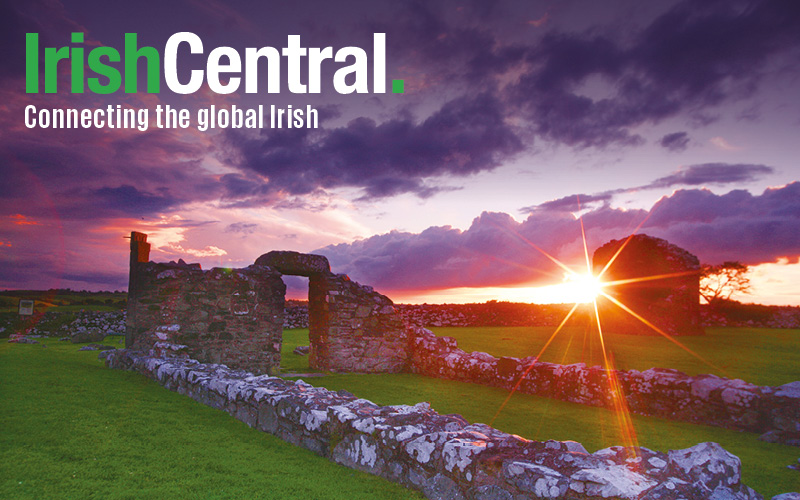The Gathering has shone a particular light on the question of why do 70 million people around the world regard their identity as Irish – what is such a sense of connection by so many people, including after several generations, all about?
I suppose one of the thoughts that I have had on this as the year has progressed is that it may perhaps have to do with the DNA of the Irish. I asked a scholar friend of mine to put a number on the length of time Irish had been the spoken language of the people of the island of Ireland until its decline and loss in the 19th century. He said about 2,500 years.
So the case can be made that the Irish – and I know there can be a big debate about that term, but let’s at least say “the people living on this island” – were a communal, clan-centred, cohesive, close-knit society with our own language for over two and a half millennia. And then, less than two hundred years ago, two seismic events intervened to change everything – the dramatic decline in the use of Irish as a spoken language, and the Great Famine which resulted in a huge portion of our people either dying or emigrating. As we know, that process of emigration has continued apace in the 170 years or so since then, accelerating in the decades after independence in 1922. As a result, there are now multiple times more people of Irish identity living overseas than there are in Ireland itself, a remarkable reality.
A thought occurred to me from all of that – it could be argued that the 170 years or so period since the Famine is actually a very brief block of time in the context of two and half millennia and not enough to alter the fundamental DNA of the Irish in terms of being a people of community and kinship.
And that therefore, whether we are aware of it or not, that context has meant that the process of separation involved in emigration over the generations has resulted in a sense of, can I call it, psychic loss, for BOTH sides – both for those who left and for those who stayed. A bit like the sensation for twins who are separated at an early stage in life and experience during their subsequent lives apart a sense of not being quite fully whole.
Before I’m taken to task by the scholars, let me fully acknowledge that there is a further dimension of course in the Ireland story in the form of the relationship with England and the consequences of that, including through the plantations of the Northern part of the island of the 17th century. The story of the Ulster Scots in the Ireland narrative and the significant numbers of that community who emigrated during the 18th and 19th century, particularly to North America, is an important piece of our demographic and diaspora jig-saw in its own right and deserving of a full study of its own. But I don’t believe it takes from the basic point I’m making above about what I would call the indigenous Irish.
I have two other interesting fragments from the field to share with you, both taken from the Irish Times.
Fragment One: In an interesting article on emigration on 21 March 2013 in the Irish Times, Ariel Glynn from NUIG included a quote from a great Maynooth Professor of my era, Fr Liam Ryan and it went like this: “Emigration is a mirror in which the Irish nation can always see its true face”. A fascinating observation by a great scholar.
Fragment Two: On 29 June 2013, the Irish Times reported on the Kennedy Gathering in Wexford the previous day. This involved the visit by over 30 members of the Kennedy clan commemorating the visit to Ireland 50 years ago of President Kennedy. The report quoted two comments from one of the Kennedy delegation, Douglas Kennedy, the youngest son of Bobby. He said that those four days of the visit to Ireland were the happiest days in the life of JFK – a pretty remarkable statement given the context. And secondly and even more profoundly, Douglas Kennedy observed that during those four days, JFK “came to himself”. He came to himself. A remarkable claim and if true what an amazing insight – and certainly one for the scholars to ponder on!
I wanted to make an attempt to add a thought of my own to Douglas Kennedy’s great insight: If JFK came to himself during the four days of that iconic visit, then perhaps so did we, the people of Ireland. Four decades after independence, with little to show for it in terms of progress, and coming out of a further episode of mass and brutal emigration in the 1950s, with a real question mark about whether we could make it as an independent country, there came into our midst this extraordinary man, the most powerful person in the world – and he was one of us. The national lift was palpable. In the face of one who had left we saw the potential of our own possibility. That is why I say perhaps in those four days we also came to ourselves.
Reading Douglas Kennedy’s comment certainly put Liam Ryan’s great insight into a new context. Perhaps that mirror Liam Ryan talked about was on full display in that farmyard in Wexford in June 1963.
But I suppose my biggest learning in the course of the Gathering was about our role here at home. My biggest exposure to the diaspora issue was during my two years as Consul General of Ireland in New York from 2005-07. I was frankly astonished by the scale of Irish America – their impact in the US, the way they shaped New York and still do today, exemplified by how the city becomes demonstrably Irish on St Patrick’s Day, not as a sop to the Irish but as a true reflection of the centrality of our people to the place. Truly amazing. I left New York to return to Ireland in 2007 with a huge sense of the possibility of the diaspora space for Ireland.
But the big shift for me as a result of the Gathering was the dawning of the realisation over the last year or so that the centre of gravity of the relationship does not lie out there but rather here at home. And that if the relationship between Ireland and its diaspora is to go to another level, the onus of first mover rests with us, the people living here in Ireland. Why? Because we are the Custodians of the Shared Home Place, the place where all the journeys began, theirs and ours. It is we, the people living here today, not those who left, who get to decide the wording of the notice on the gate of the Home Place – whether “Keep Out”, “Don’t Care” - or “Welcome Home”.
By the generous way they have embraced the Gathering, the people of Ireland have given their emphatic answer to that question and to what that notice should say. They have demonstrated in a powerful and moving way that they are willing and indeed eager to take up that role of Custodian of the Shared Home Place and extend the hand of authentic welcome to their kith around the world.
The response of the diaspora has been tremendous, as the number of visitors shows. Even more profound has been the kind of engagement that has been happening at the Gatherings, when those who stayed come together with those who left.
In a new way, what we are doing through the Gathering is assuming, this time in a very conscious and thoughtful way, our role on behalf of those who left as Custodians of the Shared Home Place, taking responsibility for doing the inviting and saying to the Scattered: “we welcome you back, home, tell us your story and we celebrate you”. The result, as I say, has been moving and powerful and I have experienced several examples of this myself over the past weeks and months.
As we enter the decade of centenaries, and move towards Ireland at 100, I’m excited, therefore, about the new era which could be opening up in the relationship between Ireland and our remarkable diapsora. Despite the distances of geography and generation, the reality is that we remain muintir to each other and that is something of potentially huge value for both sides.
What is now available is the possibility of a new understanding in the relationship between those who stayed and those who left which could have major implications for both of us.
We who live in Ireland have the opportunity to offer ourselves in a very particular way, as I have just suggested, as the Custodians of the Shared Home Place, of the Heritage we share with the diaspora and their children - and indeed as Custodians of the graves of the ancestors of those who left. They in their turn could serve as our pathfinders and support in a complex, globalised, global world, something that could have huge implications in terms of investment in Ireland, support for Irish companies and tourism. Indeed, the ConnectIreland project, driven by businessman Terry Clune, and on whose Board I serve, is one excellent example of that, whereby the diapsora is mobilised to become eyes and ears to companies around the world seeking a European base. Only launched last year, Connect Ireland has already secured several projects for Ireland, creating hundreds of jobs – and indeed the Taoiseach is announcing 75 more jobs under the programme this morning, all of them in country locations around Ireland.
Of course, like any successful partnership, two conditions would have to be fulfilled if this relationship between Ireland and its diaspora were to have the character I have just described – (a) both sides would freely and willingly have to assume their roles and (b) both sides would have to regard what the other is offering as valuable and authentic. In many ways, the lives and worlds of those who left were and are very different to those of us living here in Ireland, so we cannot automatically assume that people would be prepared to take on these roles – it would have to a freely undertaken act, viewed, as I say, as valuable and authentic both ways. But I suppose what I’m suggesting is that the Gathering is further evidence, in addition to what many of us already knew, that there remains a powerful bond and connection between Ireland and its diaspora.
Speaking of a globalised world, could I mention one other very important group in all of this in my view - the 17% of the population of Ireland that today who are foreign-born, the New Irish as they are called. The story of these people, also emigrants, who have come from other lands and chosen Ireland as their new home, is an exact parallel of the narrative of our people making theirs in other worlds. They bring with them the same energy and ambition and will to prevail that our people did to their adopted lands and thereby enrich our country just as our people enriched their new worlds. They are also very committed to Ireland and their future among us. I feel strongly that our discourse on and vision of diaspora should include them also in light of the powerful and rich contribution they have to make to our country.
So there we have it. It is over to you now, the scholars and practitioners in this fascinating world. As I said at the beginning, your role is central. For any dimension of the human journey, it makes sense that we understand it as fully as we can, both for its own sake but also so that we can decide on the wisest possible basis what to do with that knowledge. In relation to diaspora as to any other issue of the human journey, good understanding is the first pre-requisite of good action.
Historically, emigration has sat in the Irish psyche as a major negative. And without question, many of its dimensions in the Irish context have been deeply tragic for reasons we all know well.
But now almost 200 years after it began on the enormous scale that we know only too well, this is a timely moment, in the Year of the Gathering, and in the first year of the decade of centenaries, to take further stock of what the issue means in all its dimensions, and in particular to further unpack what I think we all agree is the epicentre of the Scattering, the Great Famine. One of the most moving dimensions of the Strokestown Gathering for instance is the visit of Richard Tye from Canada, a direct descendant of young Daniel Tighe, who emigrated from here during the Famine.
In that regard, I pay great tribute to Ciaran Reilly, Terry Dooley, Marian Lyons, Gerry Moran, Regina Donlon and all the team at Maynooth who are doing such fascinating work on the Strokestown Archives. I see that work as a kind of CSI on the linkage between the Famine and emigration. I think the work you are doing in following the stories and journeys of the Famine Irish is particularly fascinating, including in the way the threads of those stories and journeys continue all the way down to the present day, as exemplified by the Richard Tye story. If you combine that work with what is unfolding here in Ireland during the Gathering, perhaps we are moving towards an understanding that while the narratives of those who left were and are different to those who stayed, there is also a way in which they remain connected throughout in one over-arching narrative as well – back to Liam Ryan’s mirror.
Tim O’Connor is Chairman of The Gathering and former Irish Consul General in New York . This is an abridged version of his speech opening a conference at the Irish National Famine Museum in Strokestown County Roscommon.




Comments